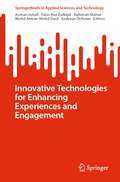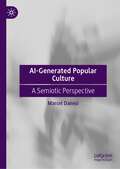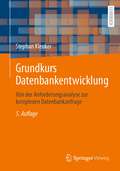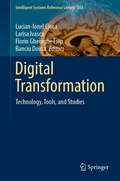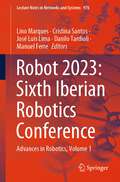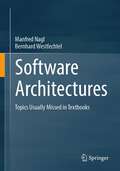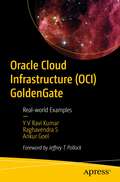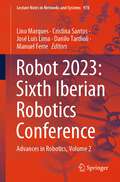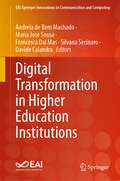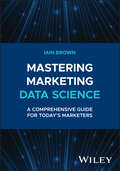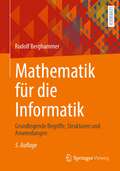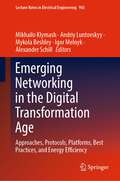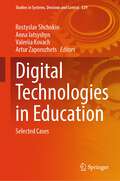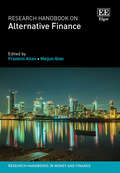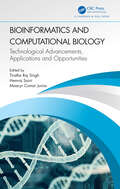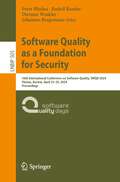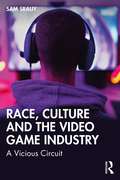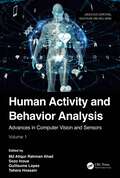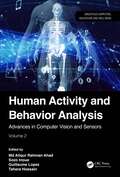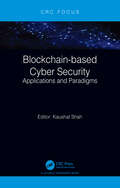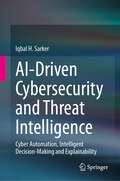- Table View
- List View
Innovative Technologies for Enhancing Experiences and Engagement (SpringerBriefs in Applied Sciences and Technology)
by Azman Ismail Fatin Nur Zulkipli Rahimah Mahat Mohd Amran Mohd Daril Andreas ÖchsnerThe book showcases how the technologies are transforming entertainment, education, and professional training, offering readers real-world examples of their applications. "Innovative Technologies for Enhancing Experiences and Engagement" is an enlightening guide that reveals how emerging technologies are shaping our world, offering insights into the evolving digital landscape and inspiring a future of more personalized, immersive, and engaging experiences.
AI-Generated Popular Culture: A Semiotic Perspective
by Marcel DanesiThis book gives a general overview of Artificial Intelligence as it is impacting on the world of the arts and culture. What is AI-generated pop culture? What does a movie, a musical work, a novel, or song created entirely by a generative AI imply in terms of our notions of creativity? What is the semiotic dynamic (the meaning-making impulse that humans imprint in sign and textual forms) that is involved in an AI-produced work? No comprehensive treatment exists of the profound implications that AI-generated pop culture entails, including how it might affect cultural evolution and how we interpret artistic artifacts. Such a treatment is critical at this moment, and this book aims to fill this gap.
Grundkurs Datenbankentwicklung: Von der Anforderungsanalyse zur komplexen Datenbankanfrage
by Stephan KleukerMit diesem Buch erhalten Studierende einen kompakten und praxisorientierten Einstieg, mit dem sie bereits früh im Studium sehr gut zurechtkommen. Die verschiedenen Phasen einer Datenbankentwicklung werden mit ihren Vorgehensweisen, Konzepten und möglichen Problemquellen vorgestellt. Gerade die Anforderungsanalyse und die Möglichkeit zur Erstellung mächtiger SQL-Anfragen werden als besonders praxisrelevante Aspekte betont. Durch die im zweiten Teil detailliert vorgestellte Integration von Datenbanken in die umgebende Software sind Studierende nach der Lektüre in der Lage, in Praxisprojekten erfolgreich mitzuarbeiten. Das Buch deckt inhaltlich eine Einführungsvorlesung vollständig ab. Die 5. Auflage wurde um das Thema JPA (Objekt-Relationale-Persistenz), Trigger in Java ergänzt. Zusätzlich werden Unterschiede zwischen Oracle, Maria DB, SQLite und Apache Derby erläutert. Neben vielen kleinen Beispielen zur Verdeutlichung einzelner Aspekte wird ein durchgehendes Beispiel genutzt. Alle Kapitel schließen mit Wiederholungsfragen und Übungsaufgaben, deren Lösungen online zum Download zur Verfügung stehen.
Digital Transformation: Technology, Tools, and Studies (Intelligent Systems Reference Library #253)
by Lucian-Ionel Cioca Larisa Ivascu Florin Gheorghe Filip Banciu DoinaThis book presents a multidisciplinary approach to digital transformation process of organizational transformation, offering support throughout the implementation process to all those interested. The digital transformation (DT) is a priority for many companies in the context of technological evolution. The use of appropriate tools, methodologies, methods, approaches, and techniques for DT, depending on the organizational characteristics, can contribute to a complete approach to organizational processes and to their efficiency. Digital transformation involves the adoption and use of new digital technologies to develop new products and services, modify existing ones and develop new business models to increase efficiency, productivity, and competitiveness. Starting from marketing to culture and education to health, automotive, engineering, mobility and human resources and others, it is addressed to professionals, practitioners, researchers, students, and other interested parties.
Robot 2023: Advances in Robotics, Volume 1 (Lecture Notes in Networks and Systems #976)
by Lino Marques Cristina Santos José Luís Lima Danilo Tardioli Manuel FerreThis text will be replaced by the correct backcovertext / informationtext as soon as we get it.
Software Architectures: Topics Usually Missed in Textbooks
by Manfred Nagl Bernhard WestfechtelThis textbook concentrates on processes, activities and results related to software architectures. It describes the separation of architecture artefacts corresponding to their nature, their logical or their modeling level on one hand and at the same time emphasizes their integration based on their mutual relations. Design or development processes demand for integration, as different artifacts must be elaborated, which are mutually dependent and need to be in a consistent form. The book is structured in four parts. The introductory Part I deals with the relevance of architectures, the central role of the design subprocess both in development or maintenance, and the importance of the decisions and artefacts in the overall result. Another topic is the spectrum of views an architecture language has to offer, and that there are different architectures to be regarded, from abstract and static to detailed, technical, and specific. Part II then discusses “important topics” onthe architecture level. It deals with adaptability especially for embedded systems, with integrating styles/ pattern notations, with different reuse forms and how to find them, with the role of architectures for integrating different existing systems, and with reverse and reengineering of legacy systems. Next, Part III covers architecture modeling and its relation to surrounding activities, as well as architectures to surrounding other results. The single chapters are on transformation between requirements and architectures, architectures and programming, architectures and project management and organization, as well as architectures and their relations to quality assurance or documentation. Eventually, Part IV summarizes the main messages and presents open problems, both for every single chapter and across chapters. Every chapter focuses on a specific problem it addresses, a question it answers, the attention it demands, a message it conveys, and further open questions it raises. The chapters are mostly independent, which implies a certain redundancy, yet it allows lecturers (and their students) to either use the book as the basis of teaching software architecture or design, or to just pick those aspects that need special attention in a more advanced course.
Oracle Cloud Infrastructure (OCI) GoldenGate: Real-world Examples
by Y V Ravi Kumar Raghavendra S Ankur GoelThis book focuses on the utilization of GoldenGate Services (GGS) in conjunction with a microservices architecture on the Oracle cloud (OCI), primarily for data migration and integration across various data sources and targets.The book begins with a practical example of utilizing GGS on a Marketplace VM, progressively advancing to in-depth discussions on implementing GoldenGate as a Service on OCI. The book offers illustrative guides for data replication between RDBMSs (such as Oracle, Postgres, and big data targets such as Kafka). Additionally, it explores monitoring techniques using Enterprise Manager and Grafana dashboards. A comparative analysis is presented between traditional VM-based GoldenGate installations and the OCI service model. Special attention is given to Zero Downtime Migration (ZDM) and leveraging GGS for database migration from on-premises to OCI. Some chapters address multi-cloud replication using OCI GGS and include real-life case studies.By the end of this book you will have gained comprehensive insights into the architectural design of GoldenGate Services and will be adept at replicating data using GGS, enabling you to replicate setups in your own environments.What You Will LearnSet up GoldenGate Services for high availability (HA), disaster recovery (DR), migration of data to cloud, and moving data into the data lake or lakehousePerform logical migration of data to the cloud using the ZDM tool (ZDM uses GoldenGate internally).Replicate data to big data targetsMonitor GGS using Enterprise Manager and GrafanaReplicate data in a multi-cloud environment Who This Book Is ForOracle database administrators who want to replicate data or use Oracle GoldenGate Services for migration and setup of high availability (HA) and disaster recovery (DR); and data engineers who want tobuild the data warehouse, data lake, data lakehouse to push data in near real-time
Robot 2023: Advances in Robotics, Volume 2 (Lecture Notes in Networks and Systems #978)
by Lino Marques Cristina Santos José Luís Lima Danilo Tardioli Manuel FerreThis book contains a selection of papers accepted for presentation and discussion at ROBOT2023, the Sixth Iberian Robotics Conference, held in the University of Coimbra, Coimbra, Portugal, during November 22nd-24th, 2023. ROBOT2023 is part of a series of conferences that are jointly organized by Sociedade Portuguesa de Robótica (SPR) / Portuguese Society for Robotics and by Sociedad Española para la Investigación y Desarrollo en Robótica (SEIDROB) / Spanish Society for Research and Development in Robotics. These conferences, now occurring with a yearly periodicity, provide a forum to roboticists mostly from Iberia, but also from other parts of the world, to present and discuss their research results, new developments, and applications in the field of Robotics. The volume 1 of this book contains 45 papers addressing fundamental aspects of mobile robotics and robot manipulation while volume 2 contains 45 papers covering the application of robotics in different domains and environments.
Digital Transformation in Higher Education Institutions (EAI/Springer Innovations in Communication and Computing)
by Andreia de Bem Machado Maria José Sousa Francesca Dal Mas Silvana Secinaro Davide CalandraThis book analyzes digital technologies being used in the teaching-learning process. The authors show how the use of AI in higher education can provide personalized education through the automation of administrative teaching tasks, software programs that favor the detection of topics that need reinforcement in the classroom, the guidance and support of students outside the classroom, and the use of data intelligently to teach and support students. In addition, the authors show how to further personalize education with the use of augmented reality, adaptive platforms, intelligent tutor systems, Chatbots, adaptive learning, computer aided instruction, MOOCs, and robotics. The authors answer questions such as: What sustainable educational technologies can be used in the teaching-learning process; How can Blockchain technology and AI be applied in higher education; How can the metaverse be applied in virtual learning environments? The book is relevant to researchers, professionals, andstudents interested in technology and education.
Mastering Marketing Data Science: A Comprehensive Guide for Today's Marketers (Wiley and SAS Business Series)
by Iain BrownUnlock the Power of Data: Transform Your Marketing Strategies with Data Science In the digital age, understanding the symbiosis between marketing and data science is not just an advantage; it's a necessity. In Mastering Marketing Data Science: A Comprehensive Guide for Today's Marketers, Dr. Iain Brown, a leading expert in data science and marketing analytics, offers a comprehensive journey through the cutting-edge methodologies and applications that are defining the future of marketing. This book bridges the gap between theoretical data science concepts and their practical applications in marketing, providing readers with the tools and insights needed to elevate their strategies in a data-driven world. Whether you're a master's student, a marketing professional, or a data scientist keen on applying your skills in a marketing context, this guide will empower you with a deep understanding of marketing data science principles and the competence to apply these principles effectively. Comprehensive Coverage: From data collection to predictive analytics, NLP, and beyond, explore every facet of marketing data science. Practical Applications: Engage with real-world examples, hands-on exercises in both Python & SAS, and actionable insights to apply in your marketing campaigns. Expert Guidance: Benefit from Dr. Iain Brown's decade of experience as he shares cutting-edge techniques and ethical considerations in marketing data science. Future-Ready Skills: Learn about the latest advancements, including generative AI, to stay ahead in the rapidly evolving marketing landscape. Accessible Learning: Tailored for both beginners and seasoned professionals, this book ensures a smooth learning curve with a clear, engaging narrative. Mastering Marketing Data Science is designed as a comprehensive how-to guide, weaving together theory and practice to offer a dynamic, workbook-style learning experience. Dr. Brown's voice and expertise guide you through the complexities of marketing data science, making sophisticated concepts accessible and actionable.
Mastering Marketing Data Science: A Comprehensive Guide for Today's Marketers (Wiley and SAS Business Series)
by Iain BrownUnlock the Power of Data: Transform Your Marketing Strategies with Data Science In the digital age, understanding the symbiosis between marketing and data science is not just an advantage; it's a necessity. In Mastering Marketing Data Science: A Comprehensive Guide for Today's Marketers, Dr. Iain Brown, a leading expert in data science and marketing analytics, offers a comprehensive journey through the cutting-edge methodologies and applications that are defining the future of marketing. This book bridges the gap between theoretical data science concepts and their practical applications in marketing, providing readers with the tools and insights needed to elevate their strategies in a data-driven world. Whether you're a master's student, a marketing professional, or a data scientist keen on applying your skills in a marketing context, this guide will empower you with a deep understanding of marketing data science principles and the competence to apply these principles effectively. Comprehensive Coverage: From data collection to predictive analytics, NLP, and beyond, explore every facet of marketing data science. Practical Applications: Engage with real-world examples, hands-on exercises in both Python & SAS, and actionable insights to apply in your marketing campaigns. Expert Guidance: Benefit from Dr. Iain Brown's decade of experience as he shares cutting-edge techniques and ethical considerations in marketing data science. Future-Ready Skills: Learn about the latest advancements, including generative AI, to stay ahead in the rapidly evolving marketing landscape. Accessible Learning: Tailored for both beginners and seasoned professionals, this book ensures a smooth learning curve with a clear, engaging narrative. Mastering Marketing Data Science is designed as a comprehensive how-to guide, weaving together theory and practice to offer a dynamic, workbook-style learning experience. Dr. Brown's voice and expertise guide you through the complexities of marketing data science, making sophisticated concepts accessible and actionable.
Mathematik für die Informatik: Grundlegende Begriffe, Strukturen und Anwendungen
by Rudolf BerghammerMathematik für die Informatik: Dieses Buch bringt Ihnen die Grundlagen beiDieses Lehrbuch bietet eine Einführung in die grundlegenden Begriffe und Strukturen der Mathematik, welche am Anfang eines Informatikstudiums relevant sind. Weiterhin demonstriert es Anwendungen von mathematischen Konzepten und Methoden in der Informatik. Diese betreffen insbesondere formale Methoden der Programmverifikation und -entwicklung und den Entwurf von generischen Programmen. Ein spezielles Konzept mit einer leicht verständlichen Vermittlung des Stoffs, vielen Beispielen mit Rückgriffen auf die Schulmathematik und detaillierten Beweisen (verbunden mit der Erklärung des logischen Hintergrunds) erleichtert den Einstieg in die Mathematik an einer wissenschaftlichen Hochschule. Dadurch werden die Studierenden auch auf spätere Begriffe und tiefergehende Anwendungen der Mathematik in der Informatik gut vorbereitet. Die 5. Auflage erweitert den Inhalt um die Grundlagen der linearen Algebra. Die Übungsaufgaben zu den einzelnen Kapitel helfen, das Erlernte zu festigen und zu kontrollieren. Zahlreiche Lösungsvorschläge am Ende des Buchs ermöglichen die Überprüfung der eigenen Lösungen.Der InhaltMengentheoretische Grundlagen • Logische Grundlagen • Allgemeine direkte Produkte und Datenstrukturen • Mathematische Beweise • Spezifikation und Programmverifikation • Spezielle Funktionen • Spezielle Relationen und gerichtete Graphen • Elementare Kombinatorik und ungerichtete Graphen • Diskrete Wahrscheinlichkeitstheorie • Generische Programmierung • Grundbegriffe algebraischer Strukturen • Formale Einführung der natürlichen Zahlen - Grundbegriffe der linearen AlgebraMit diesem Buch gelingt der Einstieg ins Informatik-StudiumMit diesem Buch schaffen Sie eine solide Basis für die Mathematikausbildung im Rahmen desInformatikstudiums. Zudem sind Sie durch die vorgestellten Problemstellungen in der Lage, selbstständig mathematische Konzepte und Methoden anzuwenden. Zielgruppen dieses Buchs über Mathematik in der Informatik sind Bachelor-Studierende in den ersten Studiensemestern folgender Fachbereiche:InformatikMathematikIngenieurwissenschaften
Emerging Networking in the Digital Transformation Age: Approaches, Protocols, Platforms, Best Practices, and Energy Efficiency (Lecture Notes in Electrical Engineering #965)
by Mikhailo Klymash Andriy Luntovskyy Mykola Beshley Igor Melnyk Alexander SchillThis book covers a range of leading-edge topics. It is suitable for teaching specialists for advanced lectures in the domains of systems architecture and distributed platforms. Furthermore, it serves as a basis for undergraduates as well as an inspiration for interesting postgraduates, looking for new challenges. It addresses a holistic view of QoS, which becomes nowadays via Digital Transformations less technically and more socially driven. This includes IoT, energy efficiency, secure transactions, blockchains, and smart contracting. Under the term Emerging Networking (EmN), we cover the steadily growing diversity of smart mobile and robotic apps and unmanned scenarios (UAV). EmN supports distributed intelligence across the combined mobile, wireless, and fixed networks in the edge-to-cloud continuum. The 6G driving factors and potentials in the mid-term are examined. Operative (emergency) networking, which assists rescue troops at sites, also belongs to the above-mentionedproblems. The EmN architecture includes the components of SDN, blockchain, and AI with efficient slicing and cloud support. The design peculiarities in dynamically changing domains, such as Smart Shopping/Office/Home, Context-Sensitive Intelligent apps, are discussed. Altogether, the provided content is technically interesting while still being rather practically oriented and therefore straightforward to understand. This book originated from the close cooperation of scientists from Germany, Ukraine, Israel, Switzerland, Slovak Republic, Poland, Czech Republic, South Korea, China, Italy, North Macedonia, Azerbaijan, Kazakhstan, France, Latvia, Greece, Romania, USA, Finland, Morocco, Ireland, and the United Kingdom. We wish all readers success and lots of inspiration from this useful book!
Digital Technologies in Education: Selected Cases (Studies in Systems, Decision and Control #529)
by Rostyslav Shchokin Anna Iatsyshyn Valeriia Kovach Artur ZaporozhetsAmong the technologies that significantly change the modern world of human existence, it is worth mentioning, first of all, digital technologies. These technologies are actively and relentlessly implemented and integrated into all spheres of human activity and society, becoming a powerful catalyst and a determining source of social development. According to such a scenario of development, society acquires the features of digital, thus defining digital technologies as its leading technology. This process is called the digital transformation of society. The wide use of digital technologies to provide free access to information and knowledge is a basic principle of the digital society. Digital society significantly changes traditional ideas about work, education, culture, communication, social and political life. The development of citizens' digital culture is the main condition for the successful construction of a digital society. Therefore, it is important to carry out scientific research and targeted training to improve the qualifications of specialists in various branches of the economy, in particular, educators and scientists to acquire digital competence. After all, these specialists are key figures in ensuring the process of digitalization of education and science. The book presents various aspects of the digital transformation of education and science. A comprehensive view of the current state and prospects of the use of digital technologies for education and science is provided. The experience of using digital technologies and tools for training and improving the qualifications of specialists of various specialties, as well as for the preparation of future PhDs, is described. The book is addressed to education workers, managers, scientists, graduate students, librarians, and all those who are interested in the process of digital transformation of education and science.
Research Handbook on Alternative Finance (Research Handbooks in Money and Finance series)
Promoting a comparative perspective, this comprehensive Research Handbook aids in the understanding of alternative finance and its values in a global setting. Readers are encouraged to view alternative finance through the lens of economic mechanisms rather than terminology.Providing a holistic review of alternative finance, this timely Research Handbook emphasizes the development dynamics between financial practices and industry, financial structures, economic considerations and technology development. Chapters examine each individual type of alternative finance and explain their network advantages, such as their responsiveness to cultural structures and business conditions, bringing to light how significant modern developments such as technological advancements may lead to dramatic changes in financial systems. Ultimately, they expand on the great variation of alternative financial practices worldwide.Balancing theory, practice and policy considerations, this Research Handbook will be essential for academics and researchers pursuing the study of finance, banking, and international business. It will additionally be highly beneficial for policymakers involved in the development of financial systems and financial regulators.
Bioinformatics and Computational Biology: Technological Advancements, Applications and Opportunities
by Tiratha Raj Singh Hemraj Saini Moacyr Comar JuniorBioinformatics and Computational Biology: Technological Advancements, Applications and Opportunities is an invaluable resource for general and applied researchers who analyze biological data that is generated, at an unprecedented rate, at the global level. After careful evaluation of the requirements for current trends in bioinformatics and computational biology, it is anticipated that the book will provide an insightful resource to the academic and scientific community. Through a myriad of computational resources, algorithms, and methods, it equips readers with the confidence to both analyze biological data and estimate predictions.The book offers comprehensive coverage of the most essential and emerging topics: Cloud-based monitoring of bioinformatics multivariate data with cloud platforms Machine learning and deep learning in bioinformatics Quantum machine learning for biological applications Integrating machine learning strategies with multiomics to augment prognosis in chronic diseases Biomedical engineering Next generation sequencing techniques and applications Computational systems biology and molecular evolution While other books may touch on some of the same issues and nuances of biological data analysis, they neglect to feature bioinformatics and computational biology exclusively, and as exhaustively. This book's abundance of several subtopics related to almost all of the regulatory activities of biomolecules from where real data is being generated brings an added dimension.
Software Quality as a Foundation for Security: 16th International Conference on Software Quality, SWQD 2024, Vienna, Austria, April 23–25, 2024, Proceedings (Lecture Notes in Business Information Processing #505)
by Peter Bludau Rudolf Ramler Dietmar Winkler Johannes BergsmannThis book constitutes the refereed proceedings of the 16th Software Quality Days Conference, SWQD 2024, held in Vienna, Austria, during April 23-25, 2024. The Software Quality Days (SWQD) conference started in 2009 and has grown to the biggest conference on software quality in Europe. The program of the SWQD conference is designed to encompass a stimulating mixture of practical presentations and new research topics in scientific presentations. The guiding conference topic of the SWQD 2024 is “Software Quality as a Foundation for Security”. The 7 full papers and 2 short papers presented in this volume were carefully reviewed and selected from 16 submissions. The papers were organized in topical sections as follows: Requirements engineering; software quality; continuous integration and deployment; communication and collaboration; artificial intelligence; and security and compliance.
Race, Culture and the Video Game Industry: A Vicious Circuit
by Sam SrauyA detailed and much needed examination of how systemic racism in the US shaped the culture, market logic, and production practices of video game developers from the 1970s until the 2010s. Offering historical analysis of the video game industries (console, PC, and indie) from a critical, political economic lens, this book specifically examines the history of how such practices created, enabled, and maintained racism through the imagined ‘gamer.’ The book explores how the cultural and economic landscape of the United States developed from the 1970s through the 2000s and explains how racist attitudes are reflected and maintained in the practices of video games production. These practices constitute a 'Vicious Circuit' that normalizes racism and the centrality of an imagined gamer identity. It also explores how the industry, from indie game developers to larger profit-driven companies, responded to changing attitudes in the 2010s, where racism and lack of diversity in games was frequently being noted. The book concludes by offering potential solutions to combat this ‘Vicious Circuit’.A vital contribution to the study of video games that will be welcomed by students and scholars in the fields of media studies, cultural studies, game studies, critical race studies, and beyond.
Race, Culture and the Video Game Industry: A Vicious Circuit
by Sam SrauyA detailed and much needed examination of how systemic racism in the US shaped the culture, market logic, and production practices of video game developers from the 1970s until the 2010s. Offering historical analysis of the video game industries (console, PC, and indie) from a critical, political economic lens, this book specifically examines the history of how such practices created, enabled, and maintained racism through the imagined ‘gamer.’ The book explores how the cultural and economic landscape of the United States developed from the 1970s through the 2000s and explains how racist attitudes are reflected and maintained in the practices of video games production. These practices constitute a 'Vicious Circuit' that normalizes racism and the centrality of an imagined gamer identity. It also explores how the industry, from indie game developers to larger profit-driven companies, responded to changing attitudes in the 2010s, where racism and lack of diversity in games was frequently being noted. The book concludes by offering potential solutions to combat this ‘Vicious Circuit’.A vital contribution to the study of video games that will be welcomed by students and scholars in the fields of media studies, cultural studies, game studies, critical race studies, and beyond.
Human Activity and Behavior Analysis: Advances in Computer Vision and Sensors: Volume 1 (Ubiquitous Computing, Healthcare and Well-being)
Human Activity and Behavior Analysis relates to the field of vision and sensor-based human action or activity and behavior analysis and recognition. The book includes a series of methodologies, surveys, relevant datasets, challenging applications, ideas, and future prospects.The book discusses topics such as action recognition, action understanding, gait analysis, gesture recognition, behavior analysis, emotion and affective computing, and related areas. This volume focuses on relevant activities in three main subject areas: Healthcare and Emotion, Mental Health, and Nurse Care Records.The editors are experts in these arenas and the contributing authors are drawn from high-impact research groups around the world. This book will be of great interest to academics, students, and professionals working and researching in the field of human activity and behavior analysis.
Human Activity and Behavior Analysis: Advances in Computer Vision and Sensors: Volume 2 (Ubiquitous Computing, Healthcare and Well-being)
Human Activity and Behavior Analysis relates to the field of vision and sensor-based human action or activity and behavior analysis and recognition. The book includes a series of methodologies, surveys, relevant datasets, challenging applications, ideas, and future prospects.The book discusses topics such as action recognition, action understanding, gait analysis, gesture recognition, behavior analysis, emotion and affective computing, and related areas. This volume focuses on two main subject areas: Movement and Sensors, and Sports Activity Analysis.The editors are experts in these arenas, and the contributing authors are drawn from high-impact research groups around the world. This book will be of great interest to academics, students, and professionals working and researching in the field of human activity and behavior analysis.
Human Activity and Behavior Analysis: Advances in Computer Vision and Sensors: Volume 2 (Ubiquitous Computing, Healthcare and Well-being)
by Md Atiqur Rahman Ahad Sozo Inoue Guillaume Lopez Tahera HossainHuman Activity and Behavior Analysis relates to the field of vision and sensor-based human action or activity and behavior analysis and recognition. The book includes a series of methodologies, surveys, relevant datasets, challenging applications, ideas, and future prospects.The book discusses topics such as action recognition, action understanding, gait analysis, gesture recognition, behavior analysis, emotion and affective computing, and related areas. This volume focuses on two main subject areas: Movement and Sensors, and Sports Activity Analysis.The editors are experts in these arenas, and the contributing authors are drawn from high-impact research groups around the world. This book will be of great interest to academics, students, and professionals working and researching in the field of human activity and behavior analysis.
Blockchain-based Cyber Security: Applications and Paradigms
by Kaushal ShahThe book focuses on a paradigm of blockchain technology that addresses cyber security. The challenges related to cyber security and the solutions based on Software Defined Networks are discussed. The book presents solutions to deal with cyber security attacks by considering real-time applications based on IoT, Wireless Sensor Networks, Cyber-Physical Systems, and Smart Grids. The book is useful for academicians and research scholars worldwide working in cyber security. It is also useful for industry experts working in cyber security.
Blockchain-based Cyber Security: Applications and Paradigms
The book focuses on a paradigm of blockchain technology that addresses cyber security. The challenges related to cyber security and the solutions based on Software Defined Networks are discussed. The book presents solutions to deal with cyber security attacks by considering real-time applications based on IoT, Wireless Sensor Networks, Cyber-Physical Systems, and Smart Grids. The book is useful for academicians and research scholars worldwide working in cyber security. It is also useful for industry experts working in cyber security.
AI-Driven Cybersecurity and Threat Intelligence: Cyber Automation, Intelligent Decision-Making and Explainability
by Iqbal H. SarkerThis book explores the dynamics of how AI (Artificial Intelligence) technology intersects with cybersecurity challenges and threat intelligence as they evolve. Integrating AI into cybersecurity not only offers enhanced defense mechanisms, but this book introduces a paradigm shift illustrating how one conceptualize, detect and mitigate cyber threats. An in-depth exploration of AI-driven solutions is presented, including machine learning algorithms, data science modeling, generative AI modeling, threat intelligence frameworks and Explainable AI (XAI) models. As a roadmap or comprehensive guide to leveraging AI/XAI to defend digital ecosystems against evolving cyber threats, this book provides insights, modeling, real-world applications and research issues. Throughout this journey, the authors discover innovation, challenges, and opportunities. It provides a holistic perspective on the transformative role of AI in securing the digital world.Overall, the useof AI can transform the way one detects, responds and defends against threats, by enabling proactive threat detection, rapid response and adaptive defense mechanisms. AI-driven cybersecurity systems excel at analyzing vast datasets rapidly, identifying patterns that indicate malicious activities, detecting threats in real time as well as conducting predictive analytics for proactive solution. Moreover, AI enhances the ability to detect anomalies, predict potential threats, and respond swiftly, preventing risks from escalated. As cyber threats become increasingly diverse and relentless, incorporating AI/XAI into cybersecurity is not just a choice, but a necessity for improving resilience and staying ahead of ever-changing threats. This book targets advanced-level students in computer science as a secondary textbook. Researchers and industry professionals working in various areas, such as Cyber AI, Explainable and Responsible AI, Human-AI Collaboration, Automation and Intelligent Systems, Adaptive and Robust Security Systems, Cybersecurity Data Science and Data-Driven Decision Making will also find this book useful as reference book.
